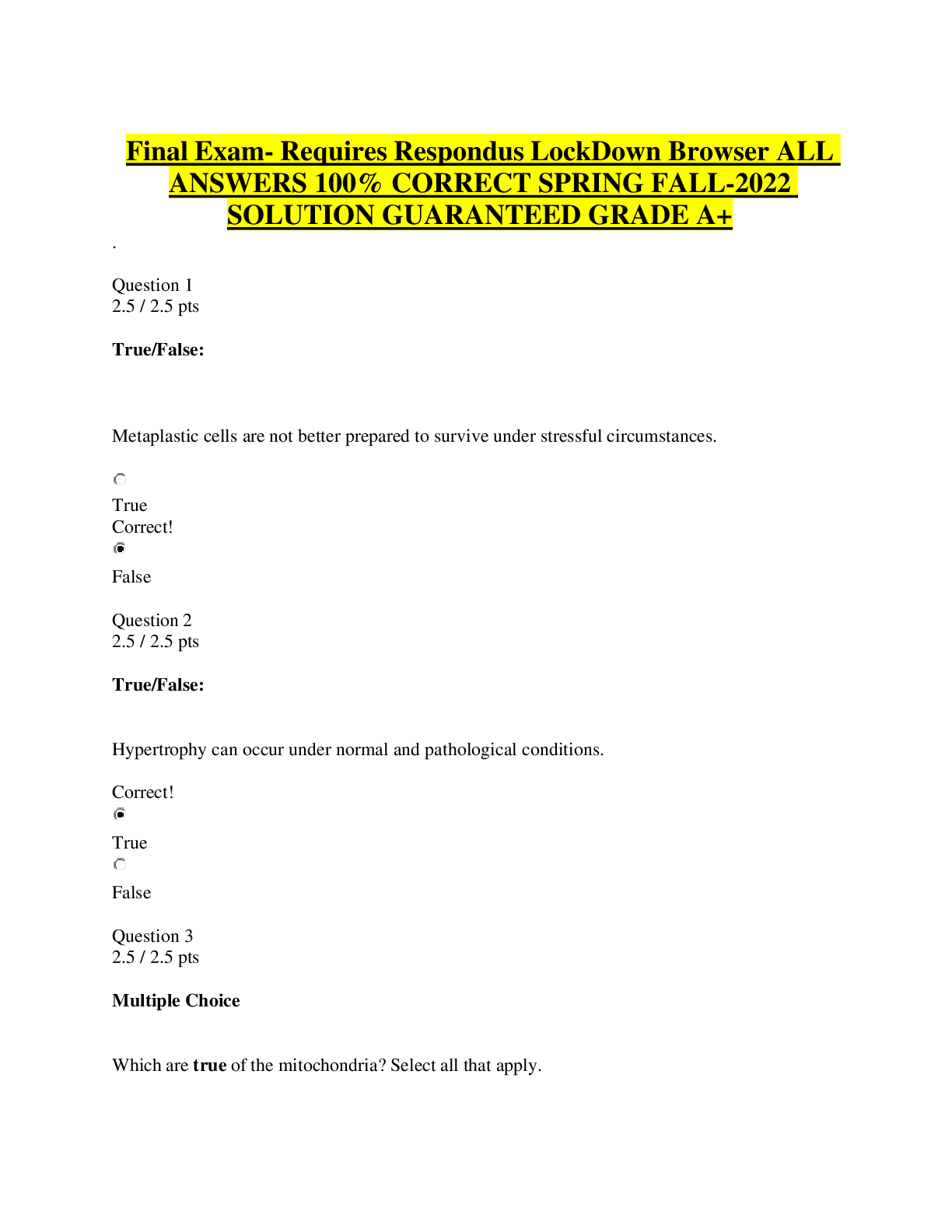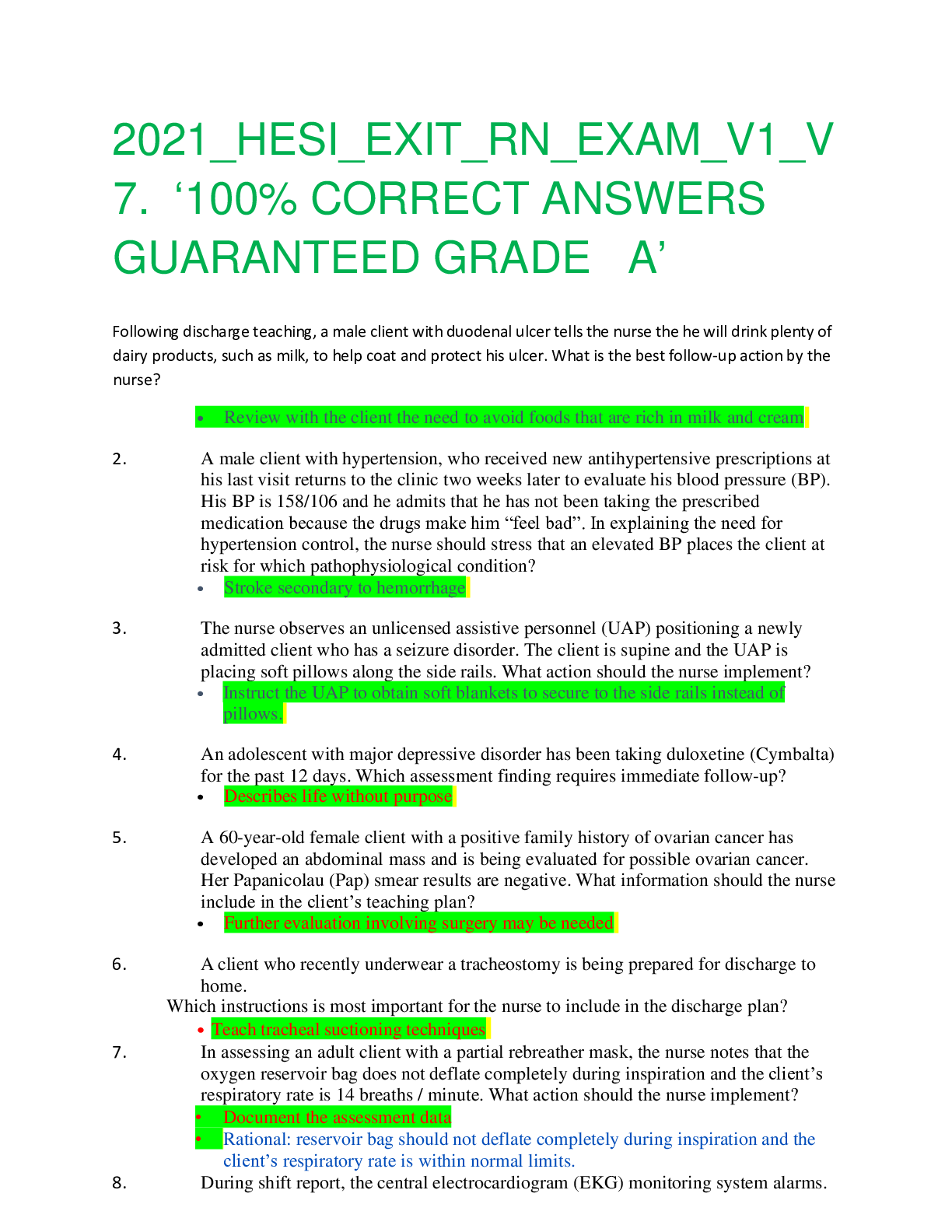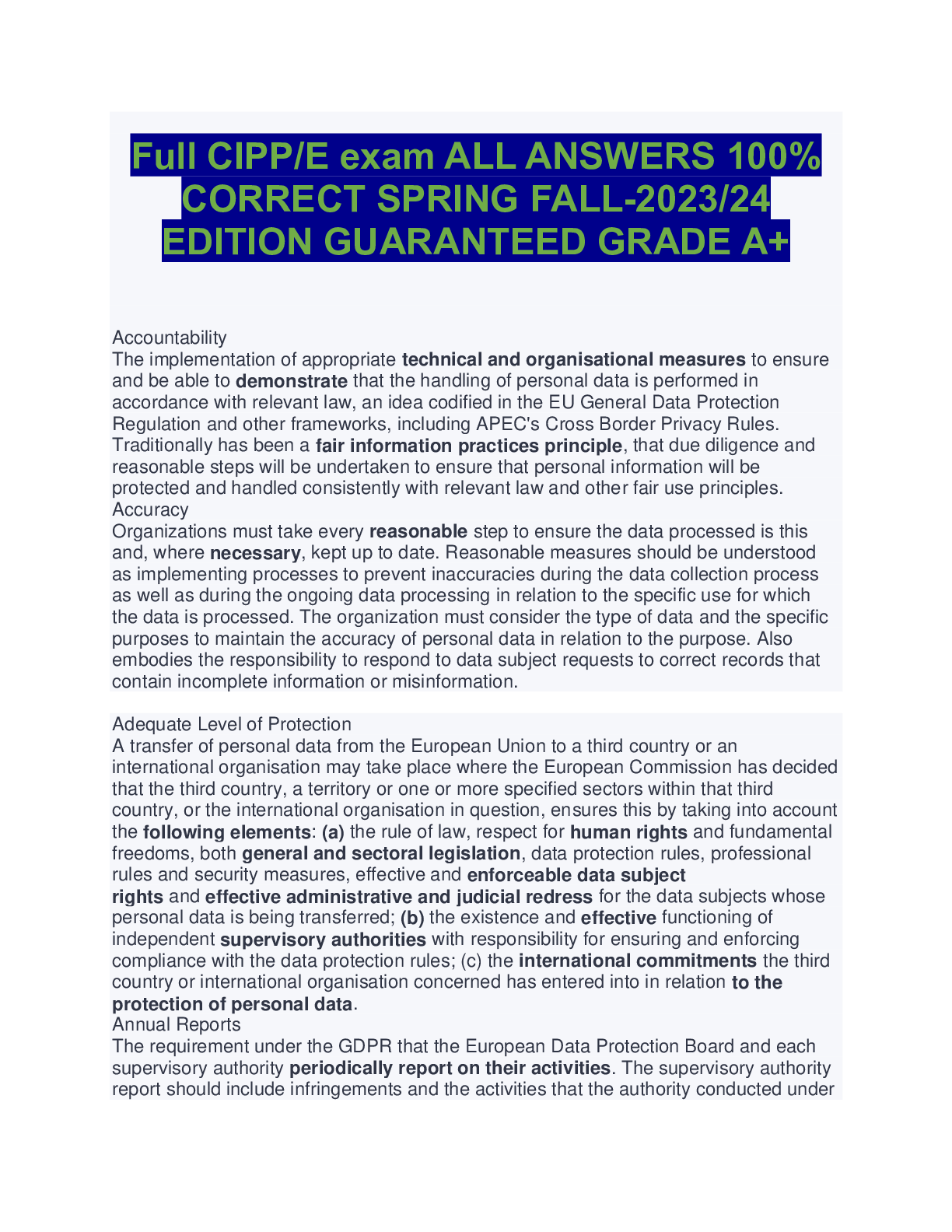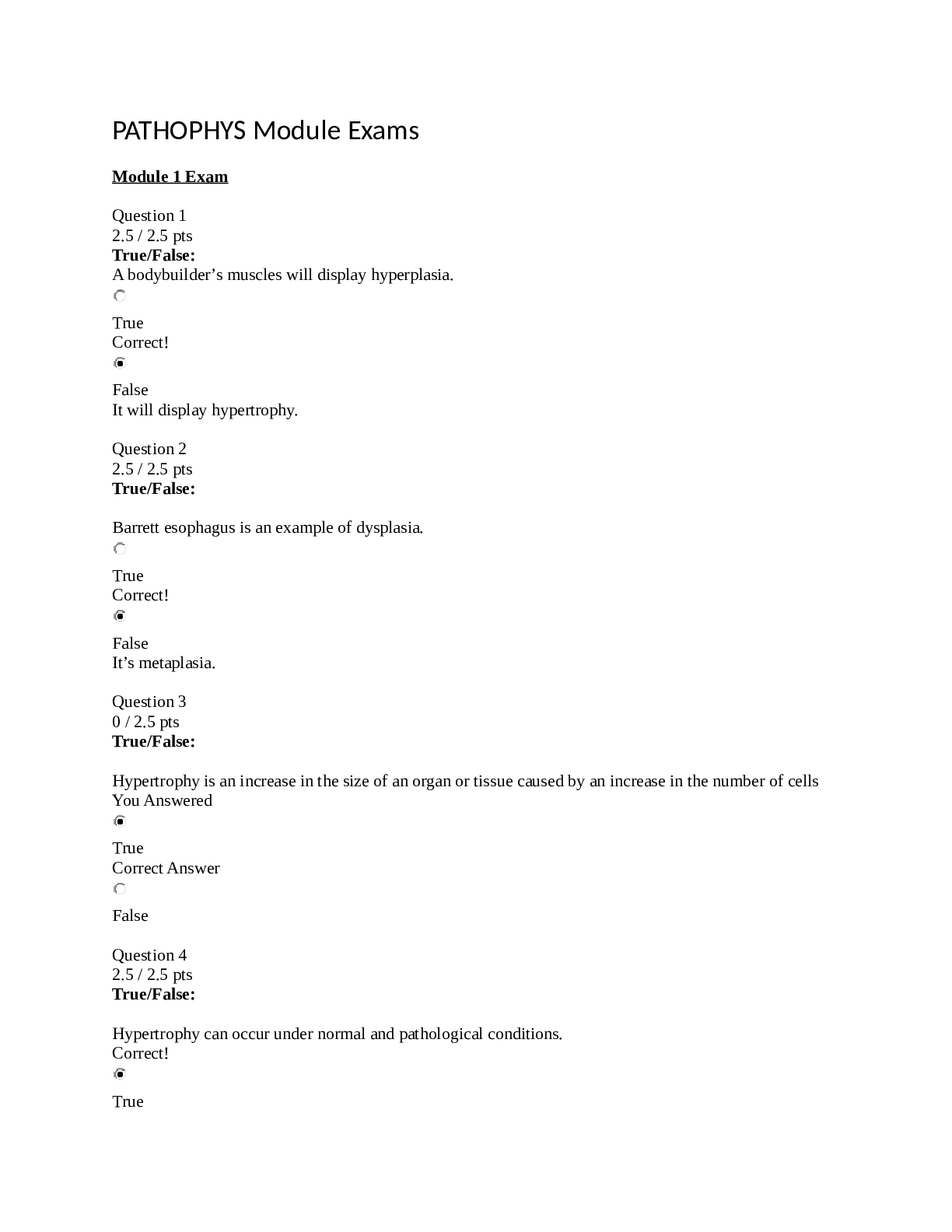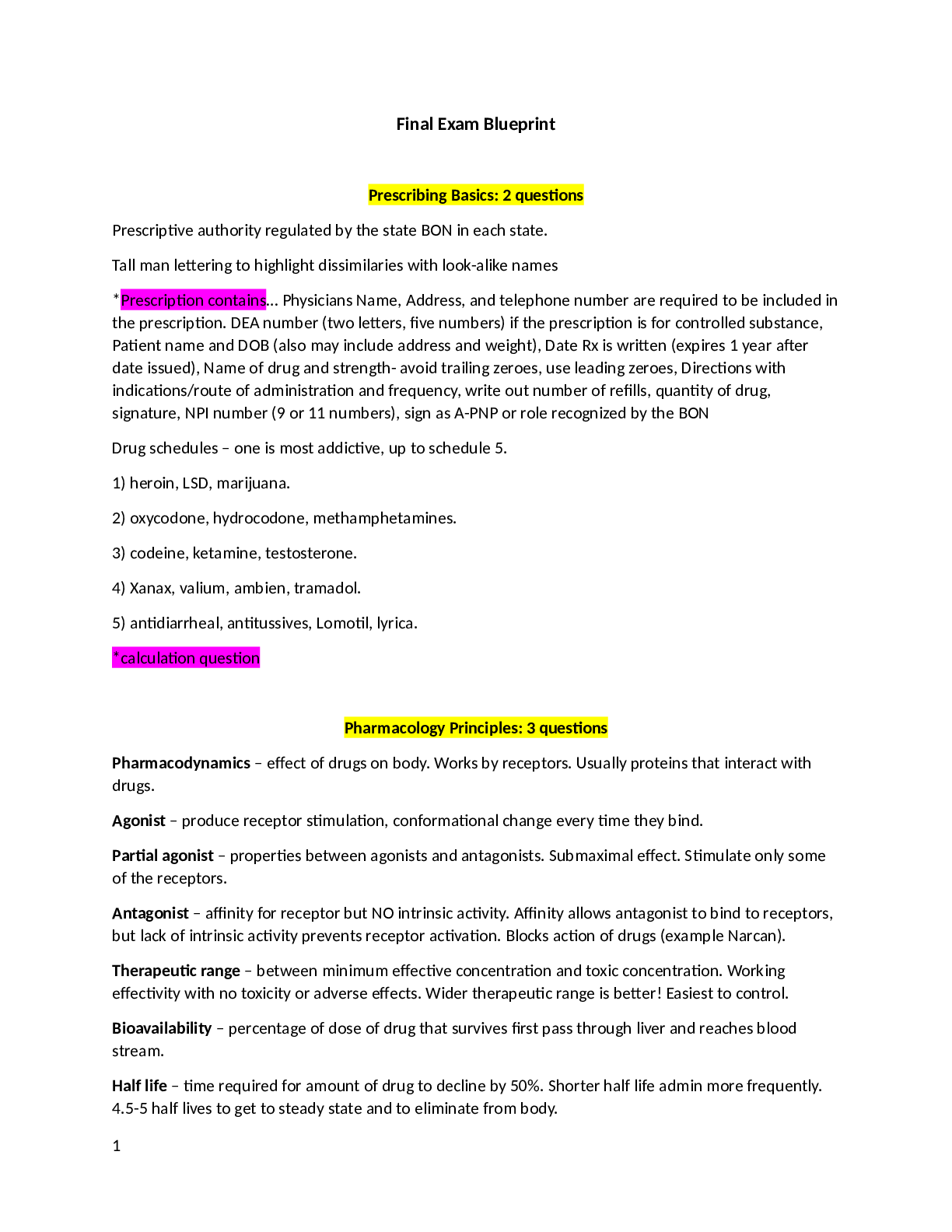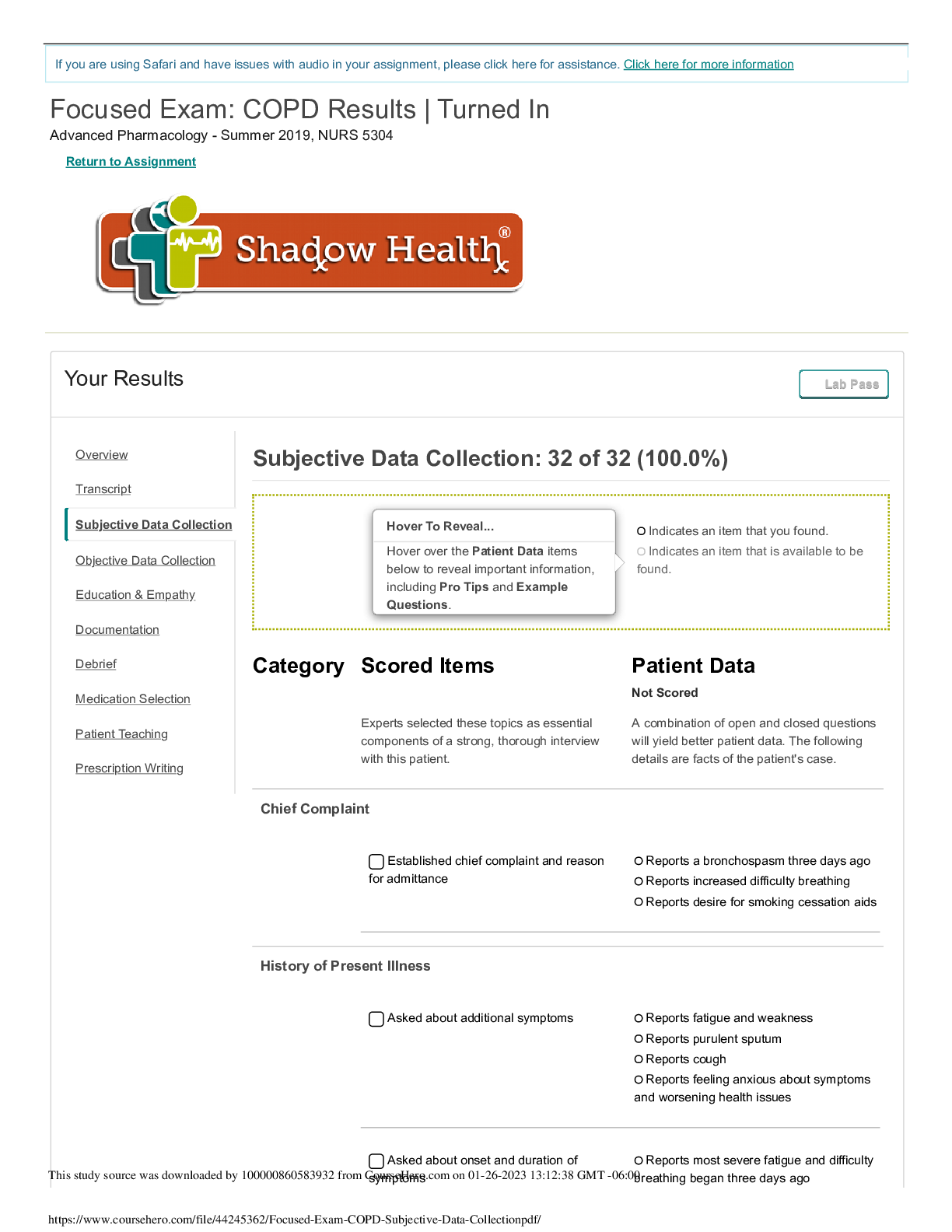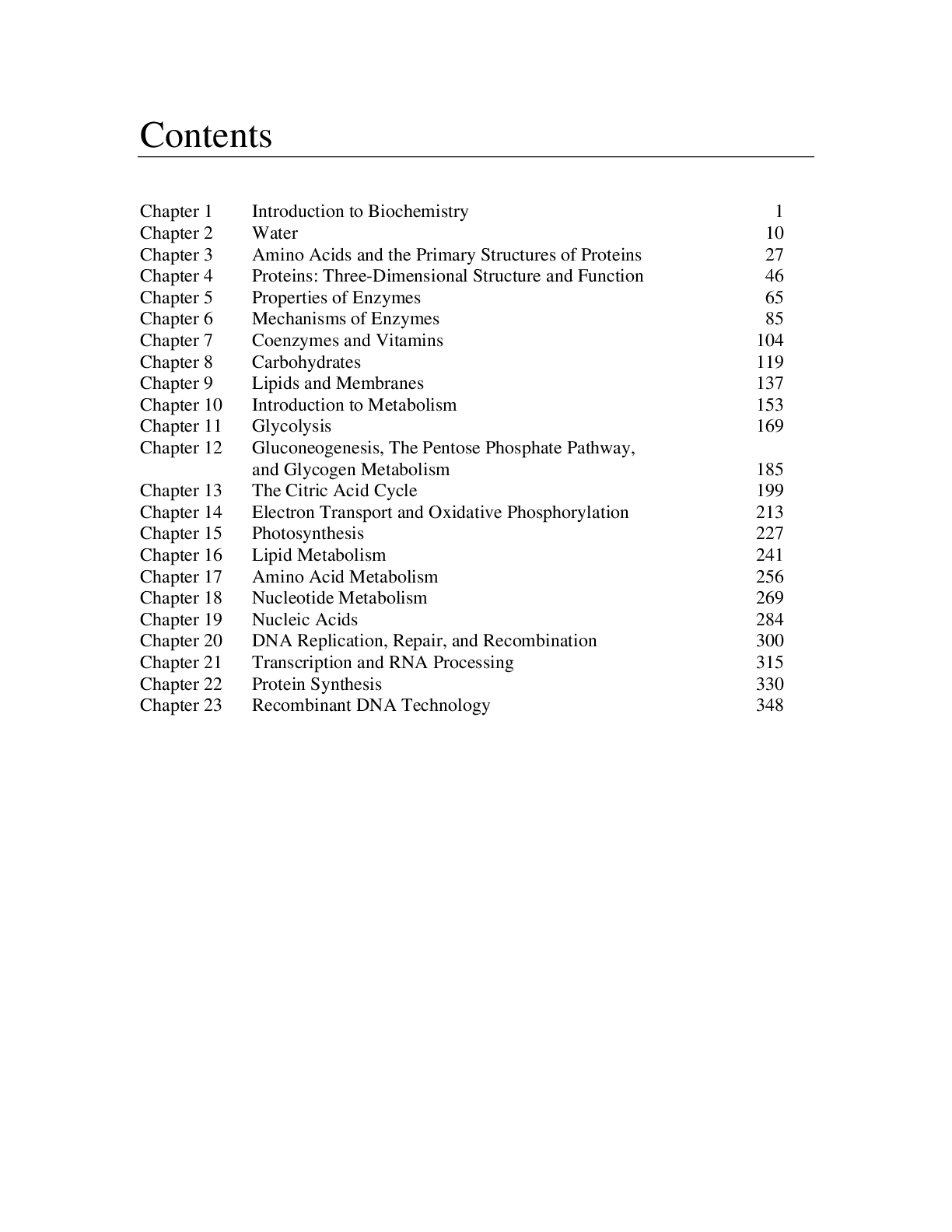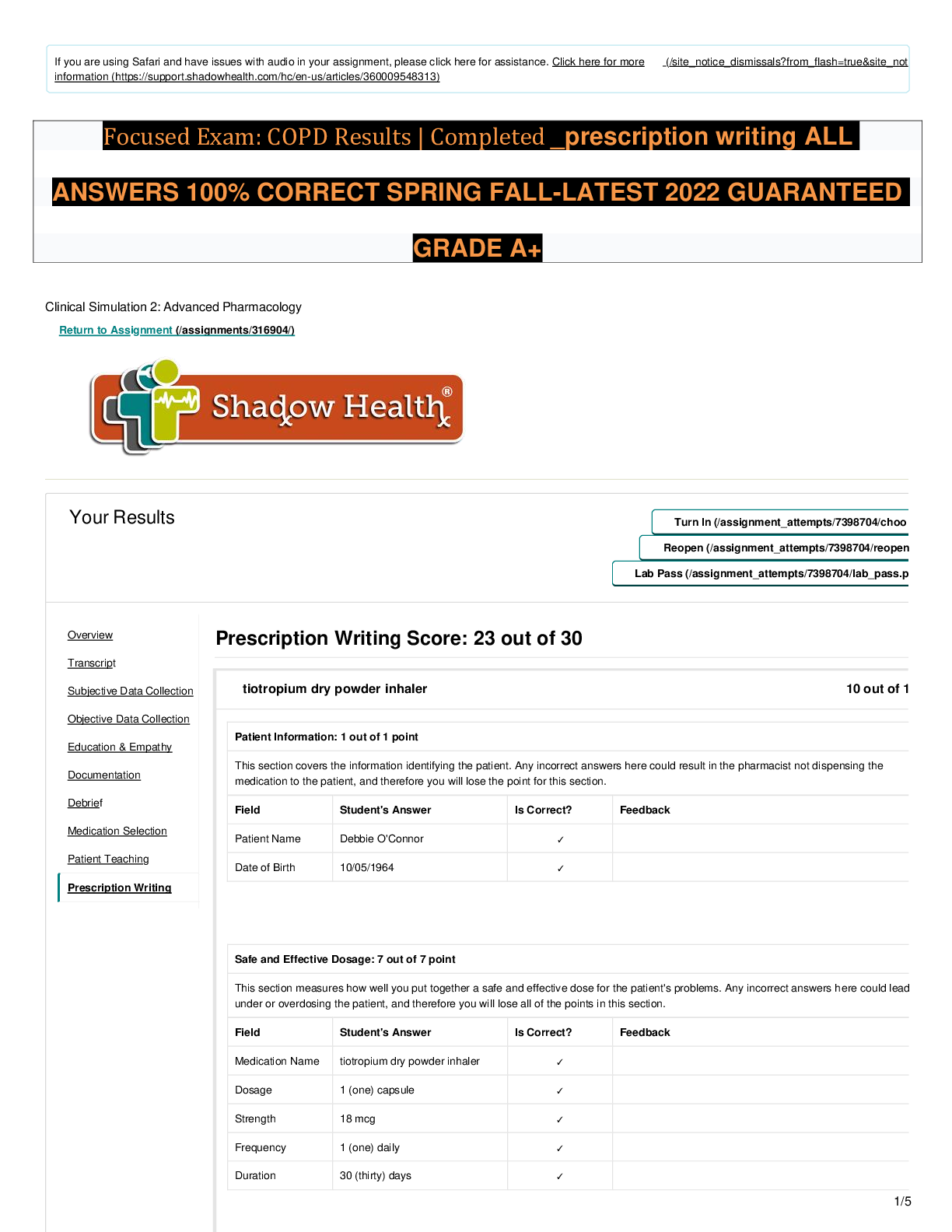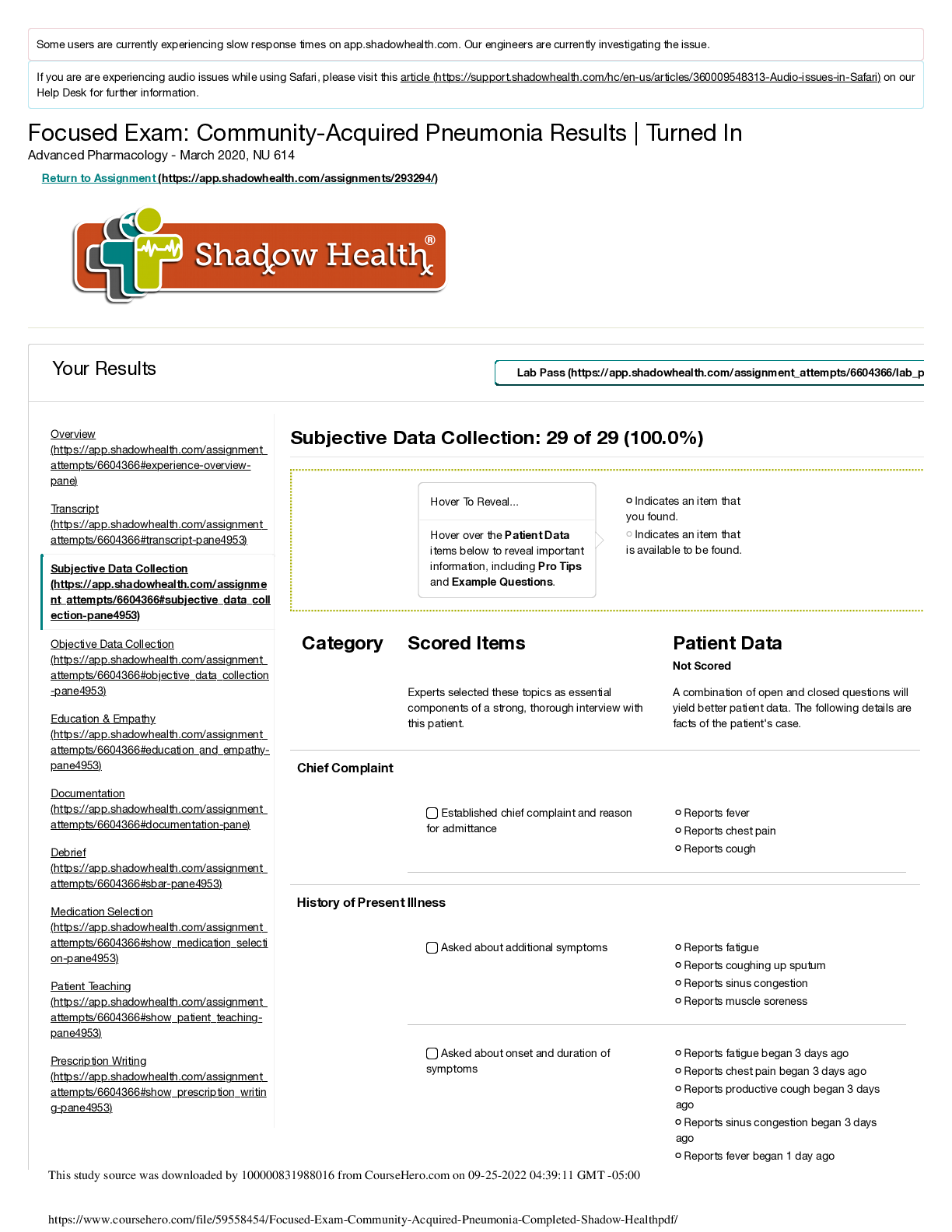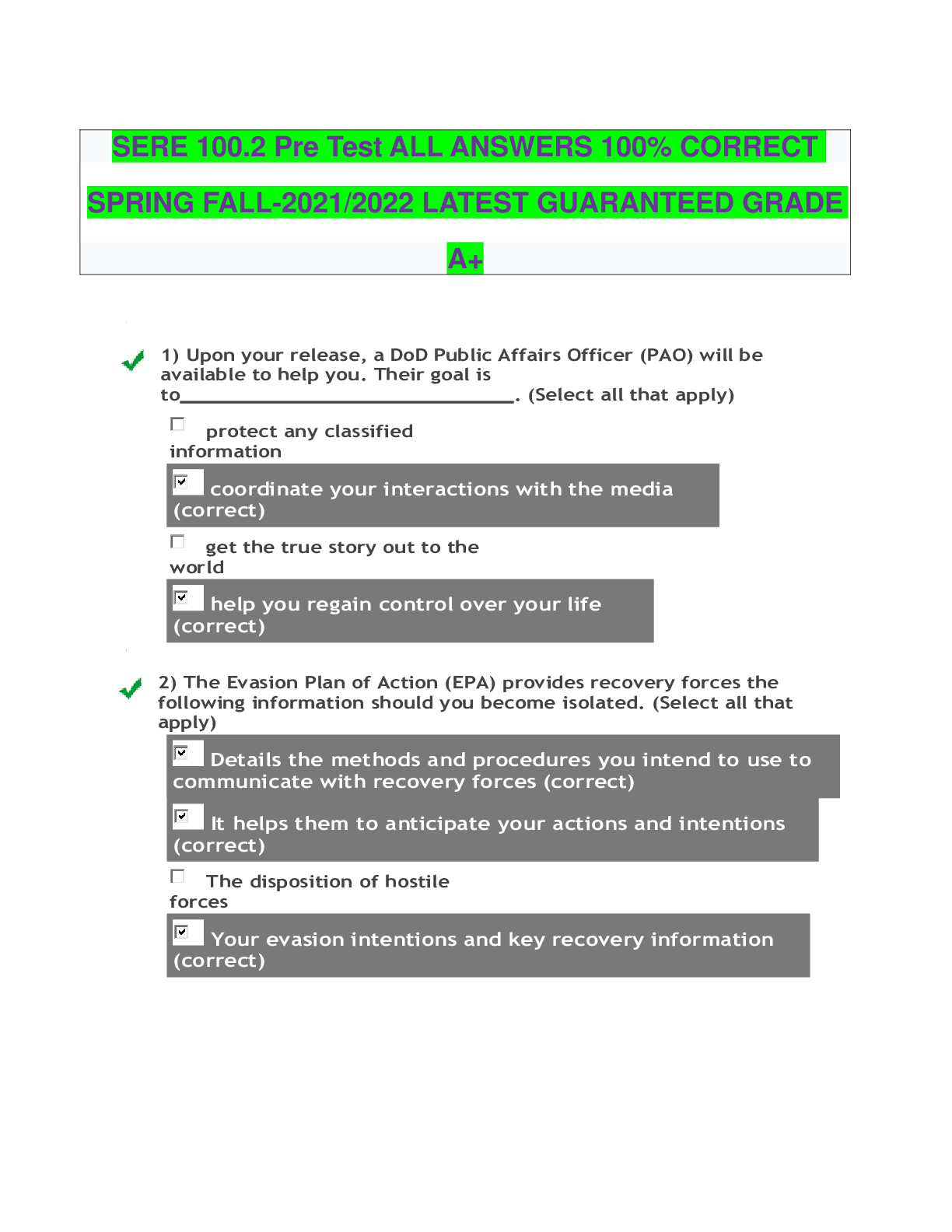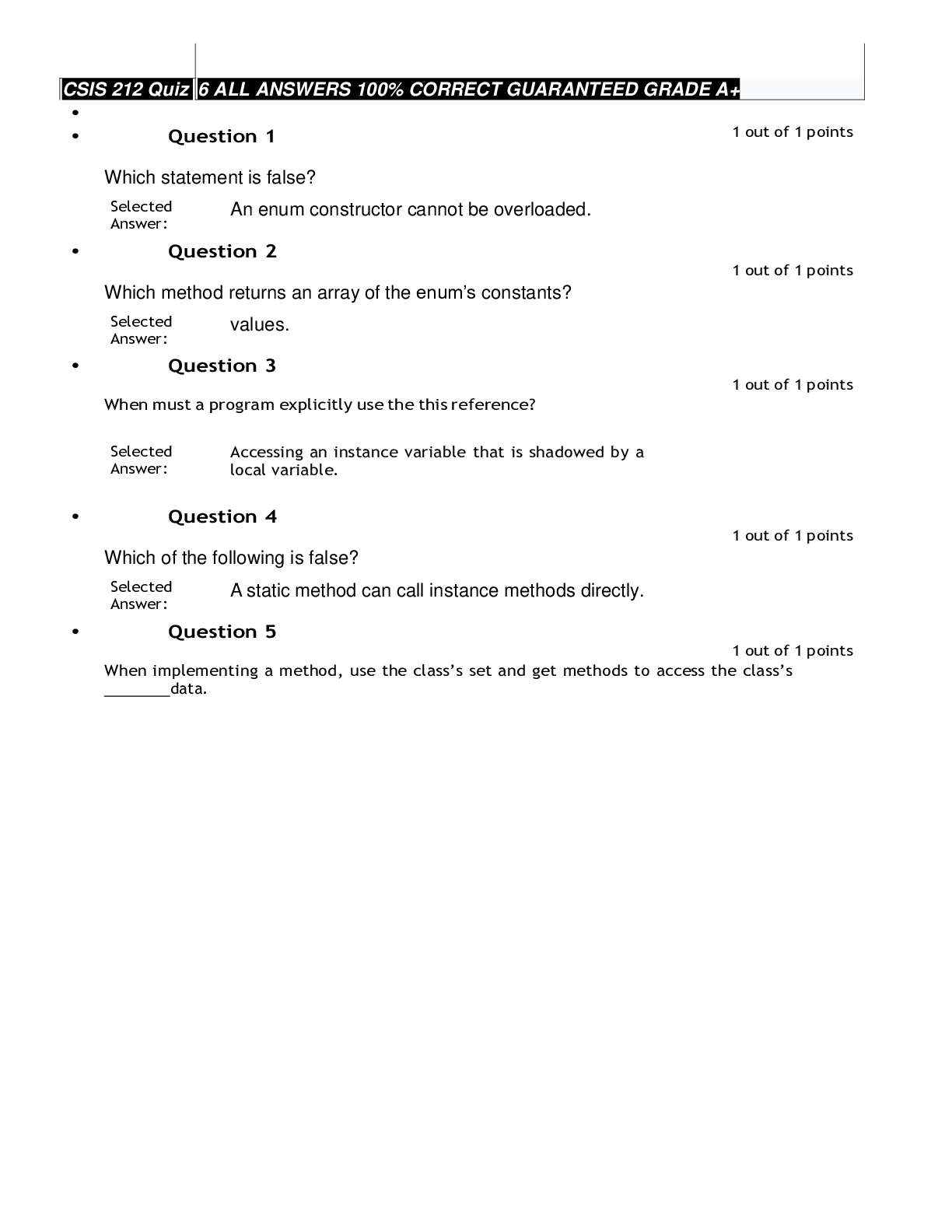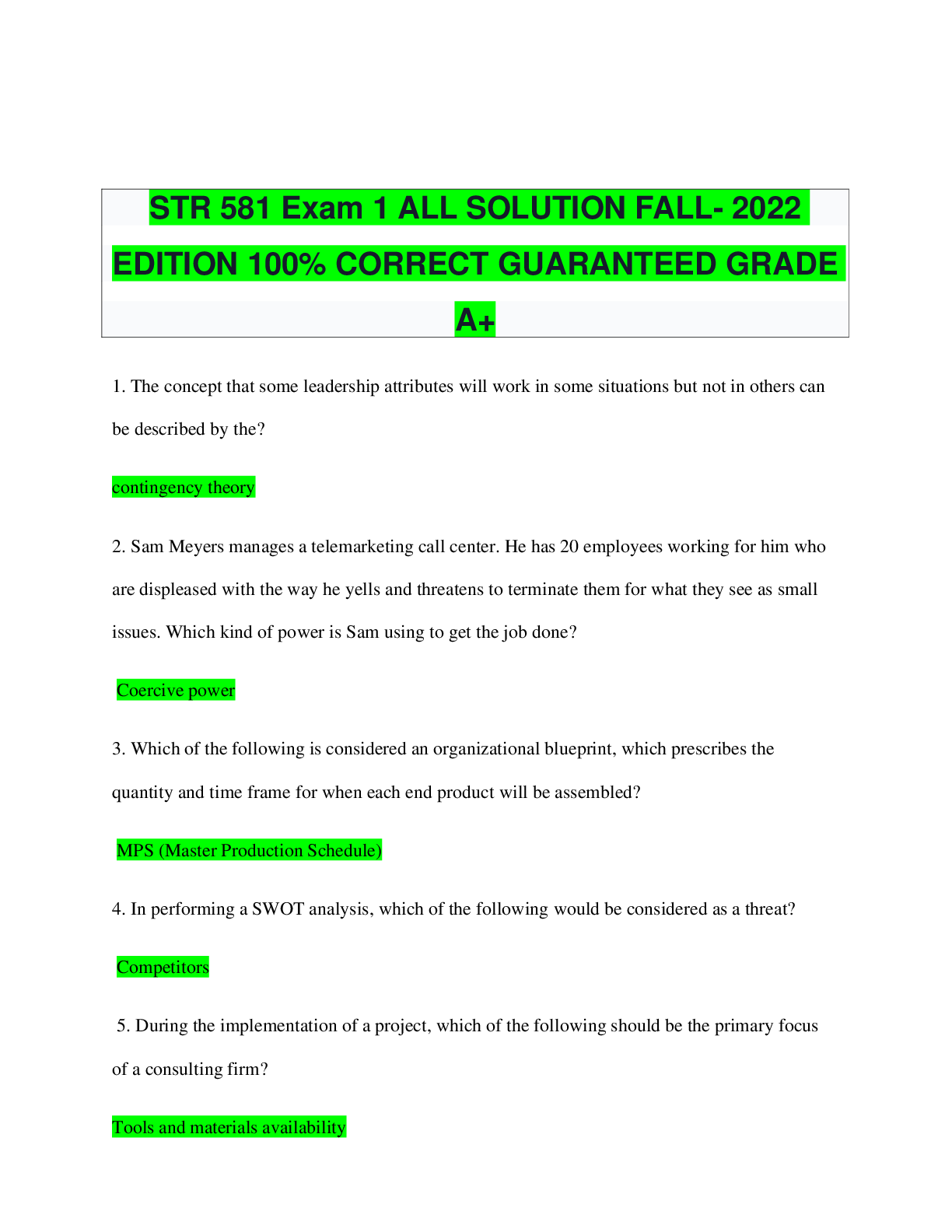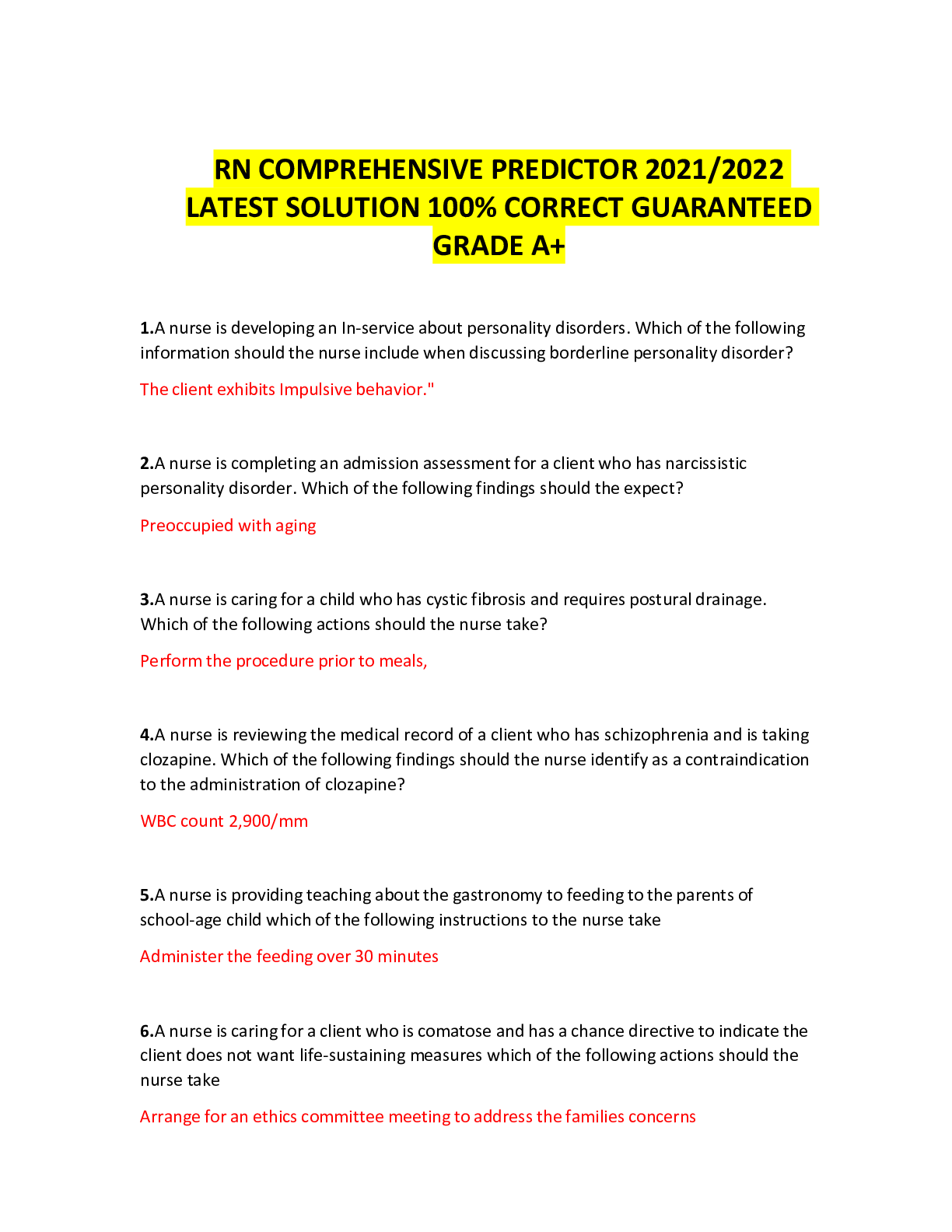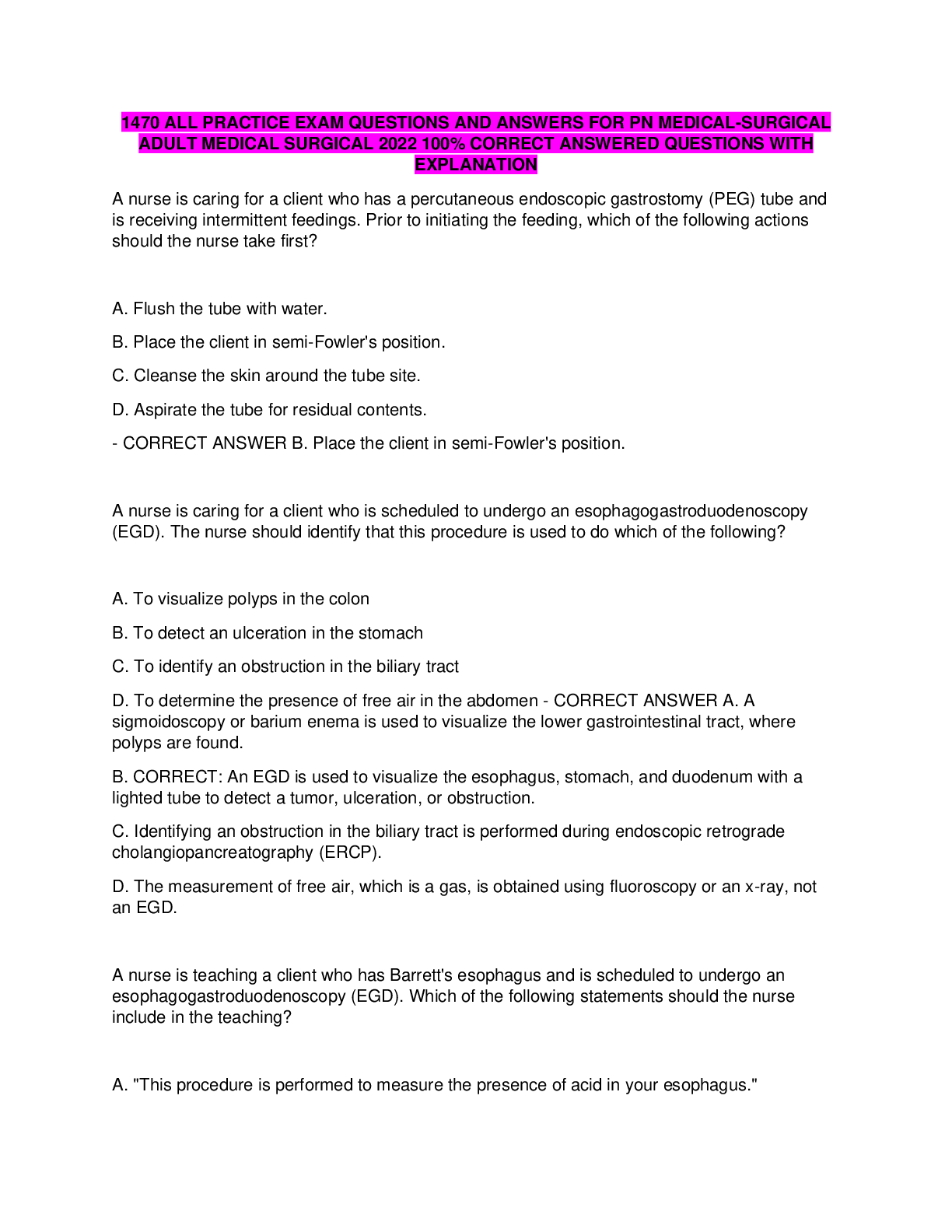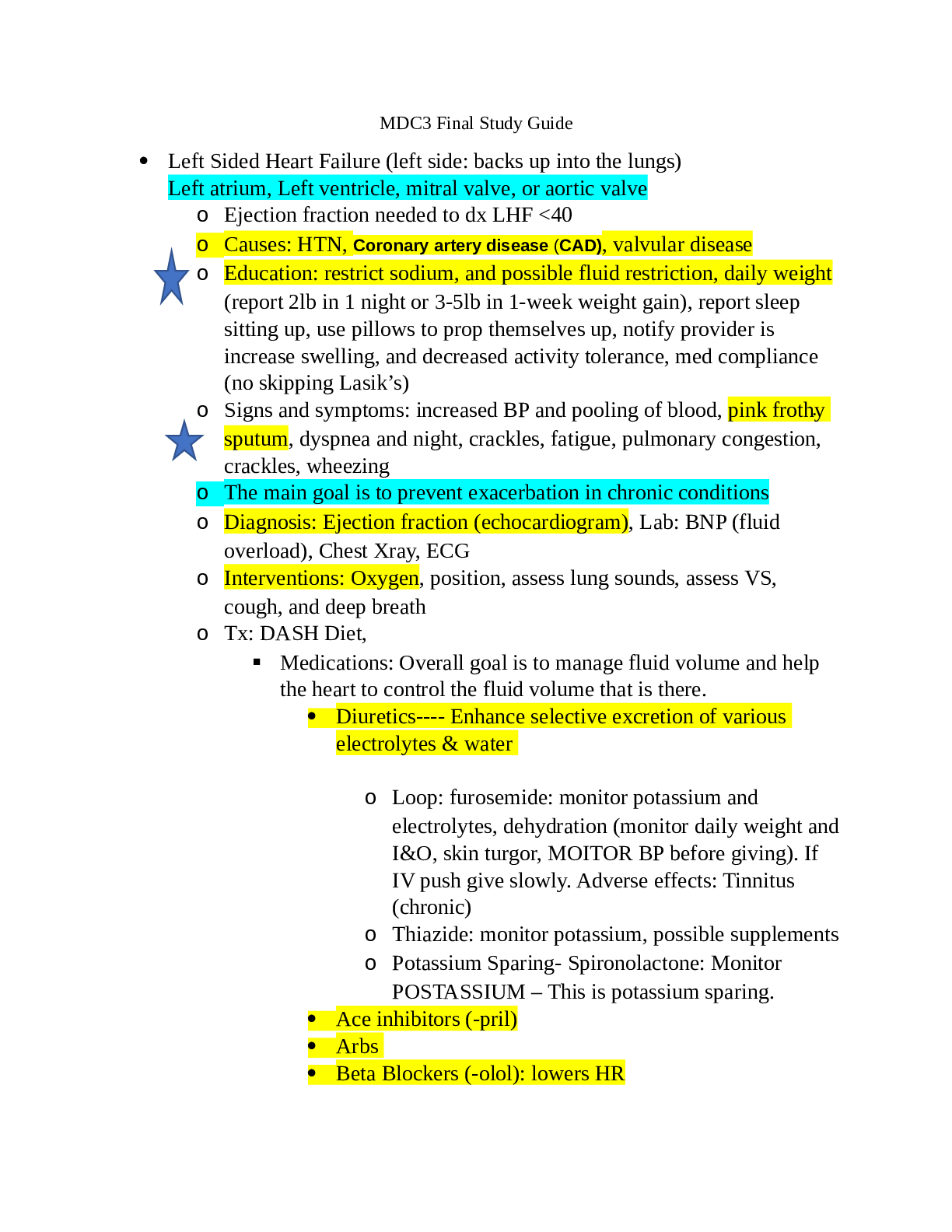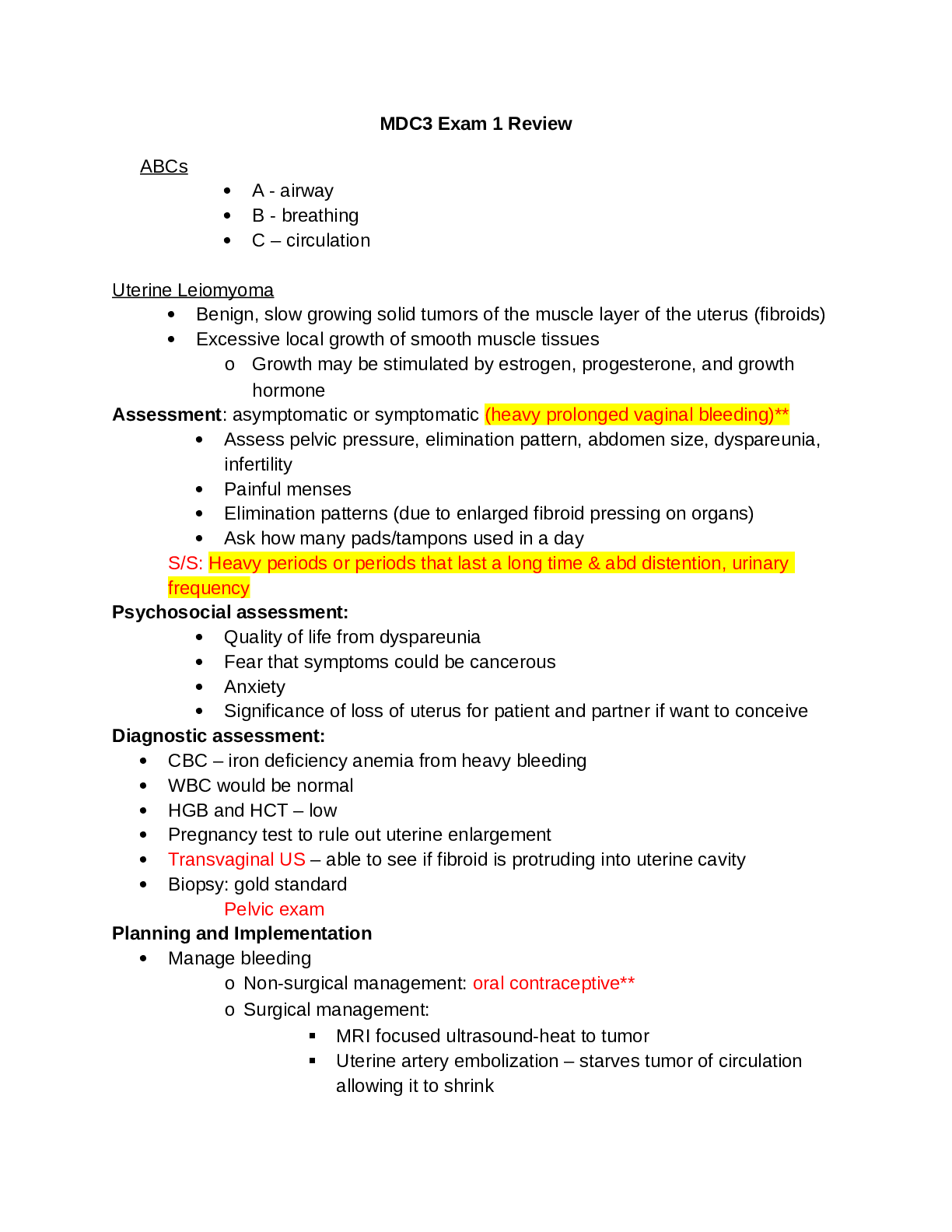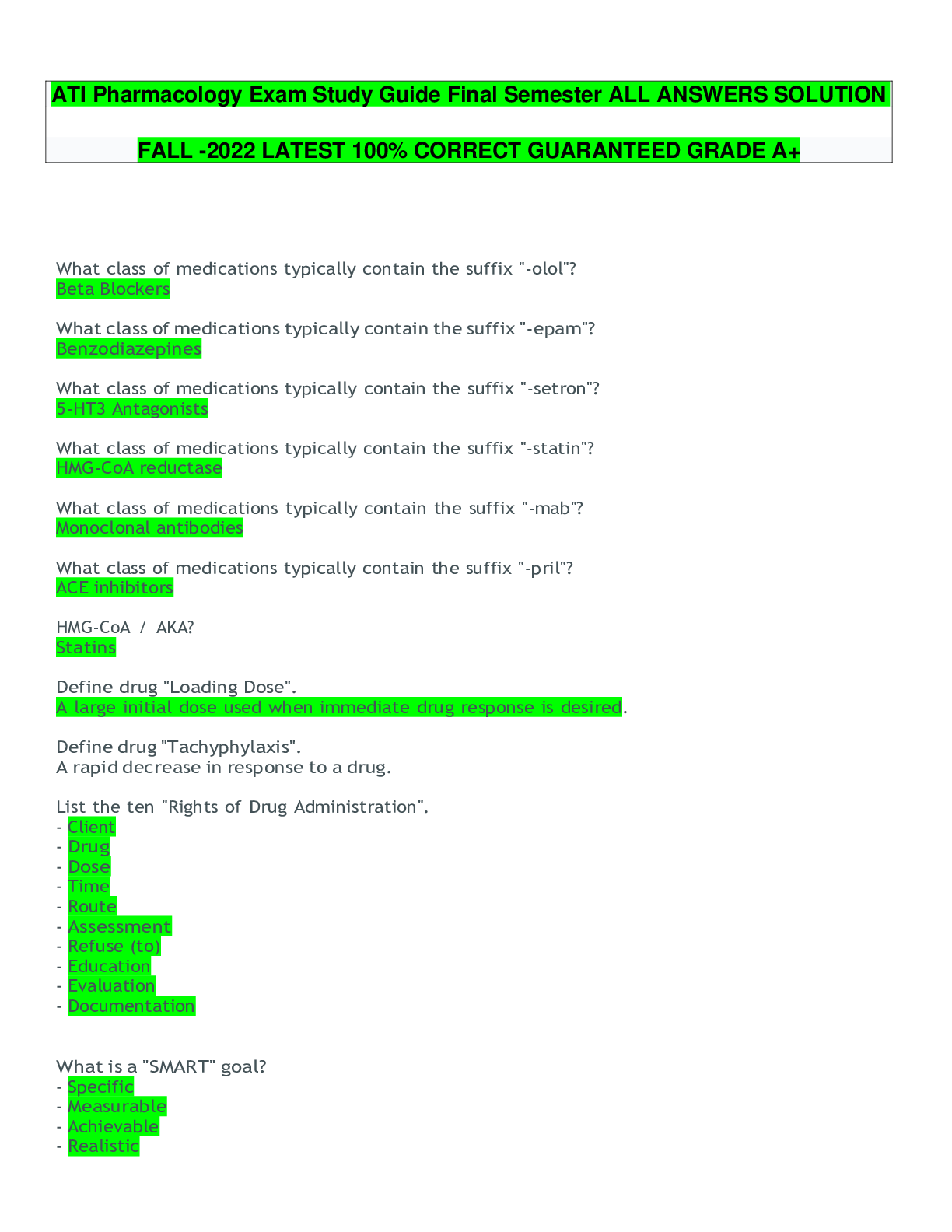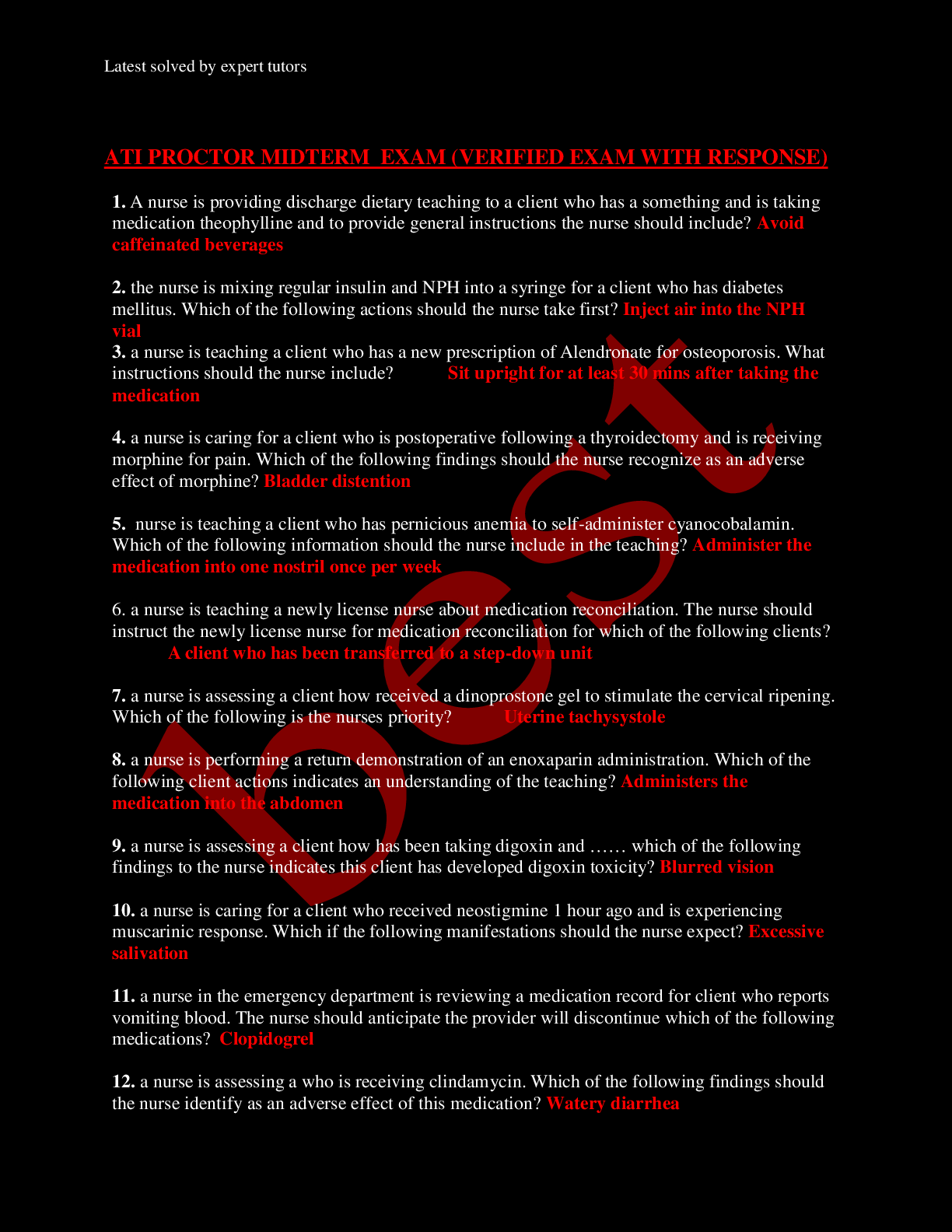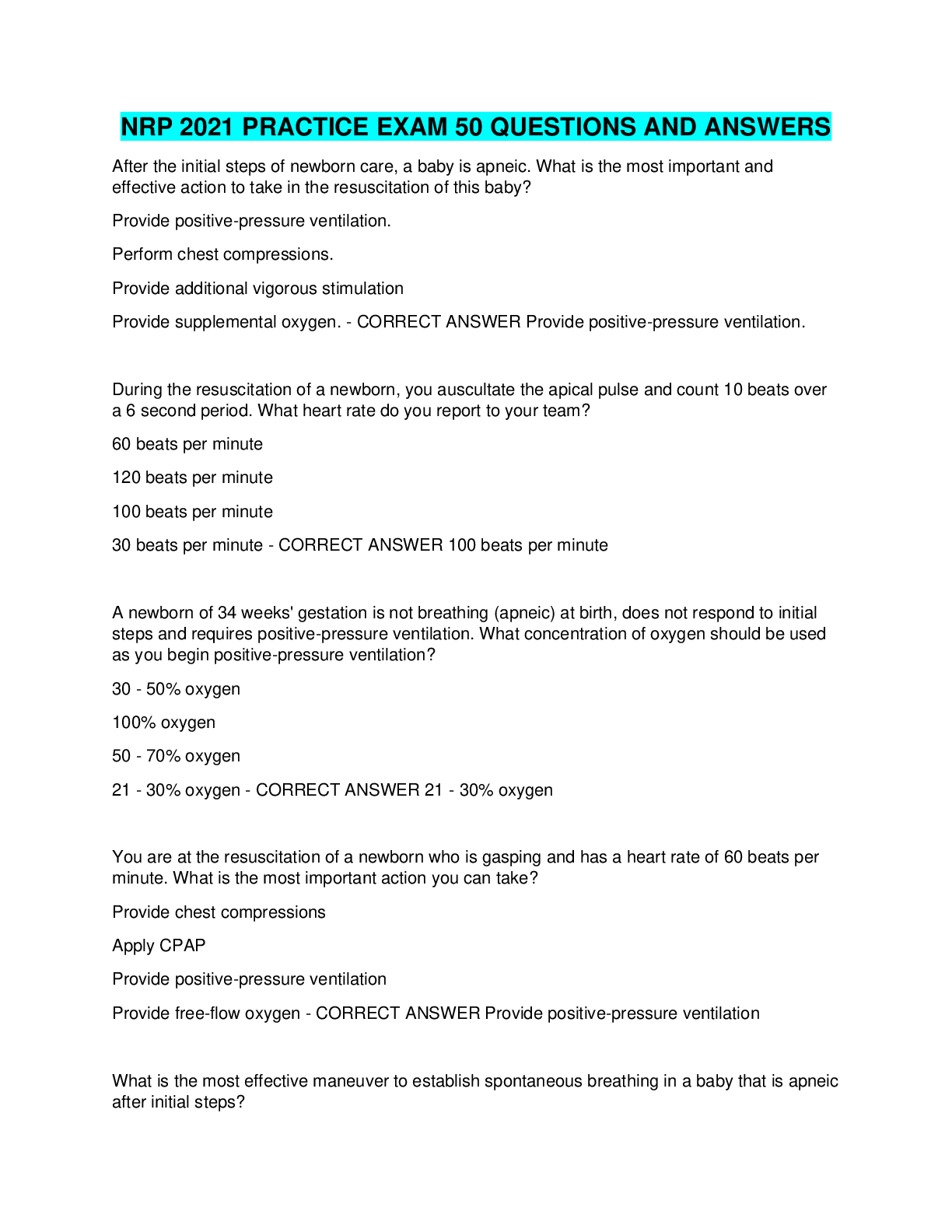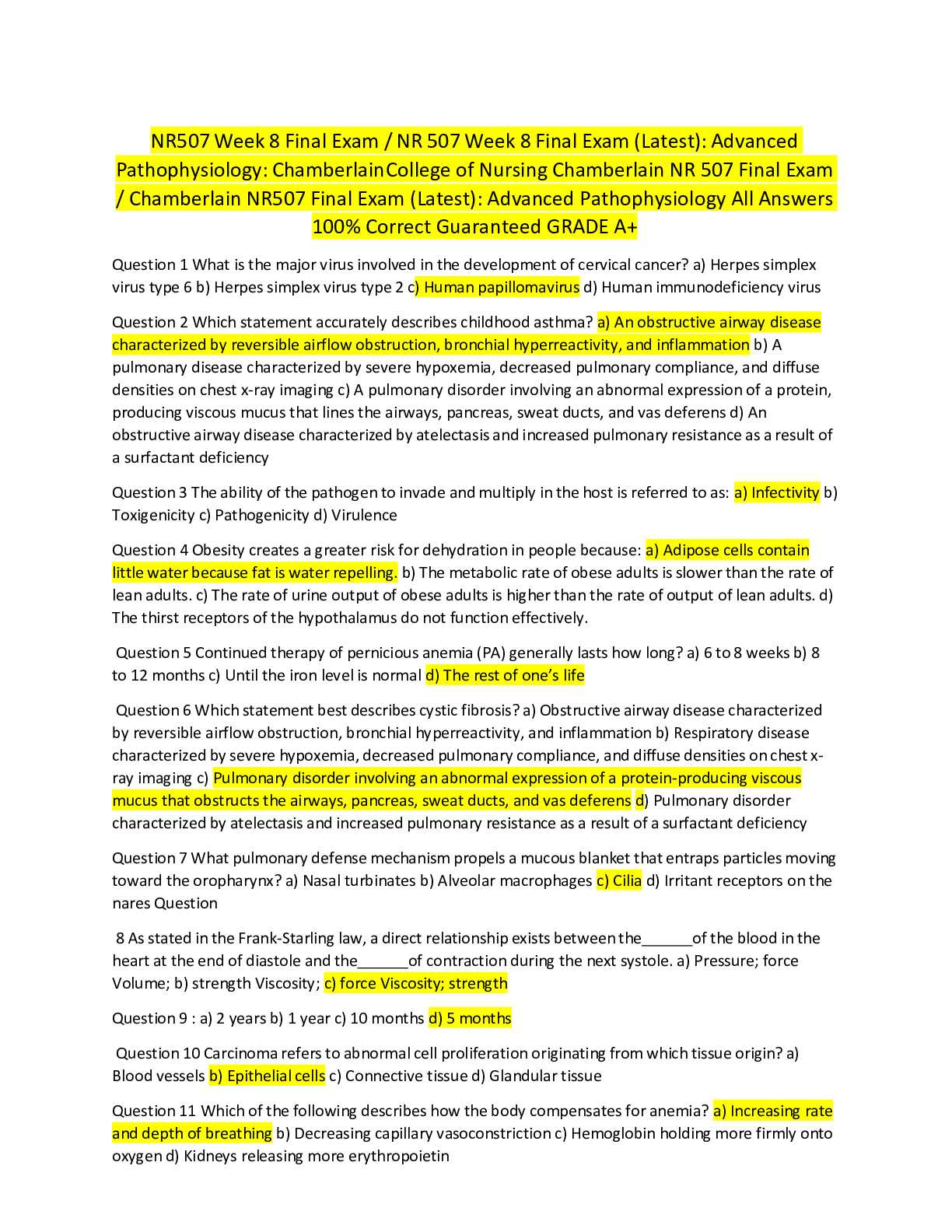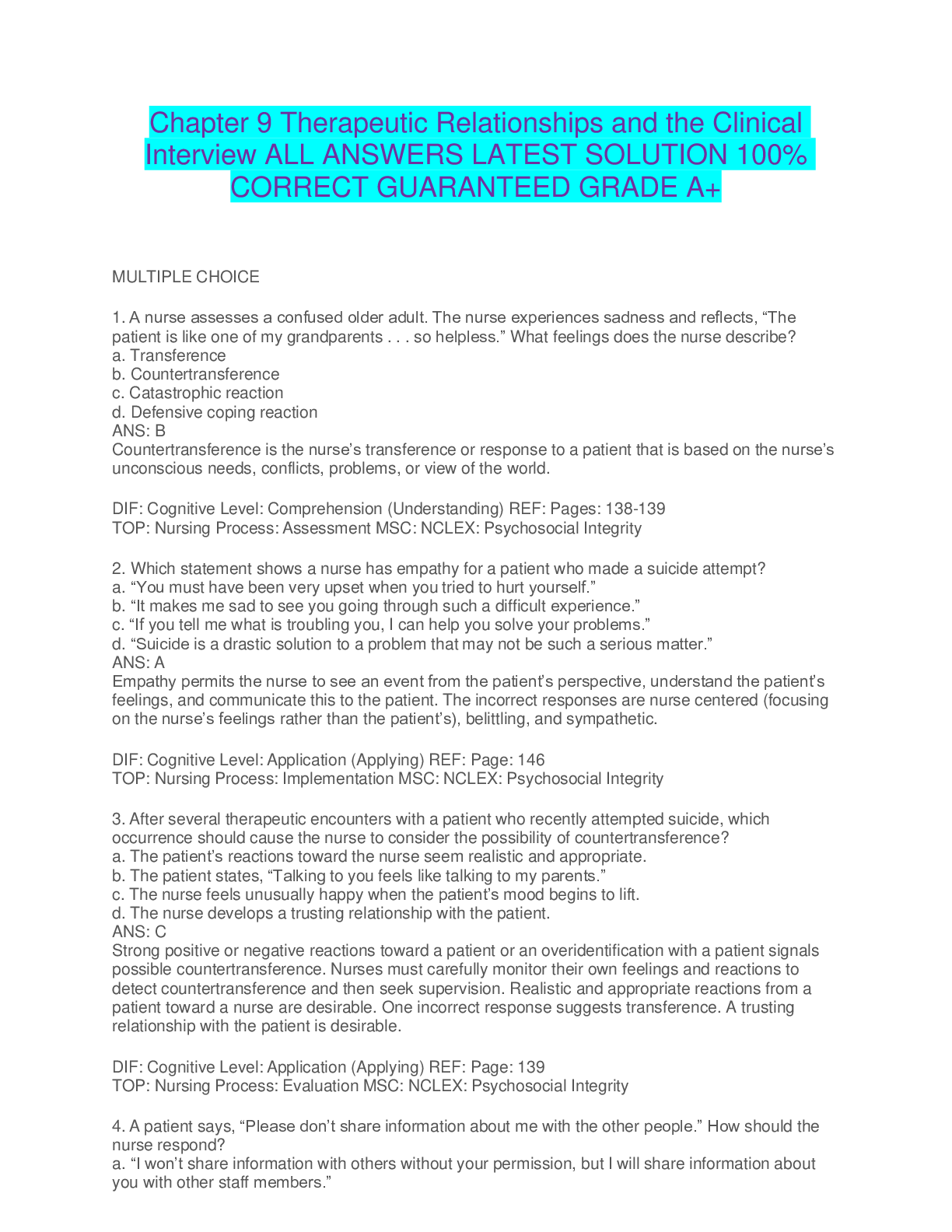healthcare > EXAM > ANCC Adult Gerontology Acute Care LATEST EDITION 2024 ALL SOLUTION 100% CORRECT GUARANTEED GRADE A+ (All)
ANCC Adult Gerontology Acute Care LATEST EDITION 2024 ALL SOLUTION 100% CORRECT GUARANTEED GRADE A+
Document Content and Description Below
Cardiac Index 2-4 SVR/Afterload 800-1200 MAP mean CVx80/CO PA pressure 15-30 Wedge PCWP pressure 6-12 Hypovolemic Shock Parameters Preload CVP decreased, SVR afterload increased, CI decreas... ed, Oxygen delivery Decreased, Venous Oxygen saturation increased Types of hypovolemic shock Hemorrhage, burns, pancreatitis Cardiogenic shock parameters CVP preload increased, SVR afterload increased, CI decreased, oxygen delivery decreased, SV02 decreased Types of cardiogenic shock Post mi, malignant dysrhythmia, acute myocarditis Obstructive shock parameters Preload either, SVR increased, CI decreased, oxygen delivery decreased, SV02 decreased Types of obstructive shock Tension pneumo, cardiac tamponade, PE Distributive shock parameters Preload CVP decreased, afterload SVR decreased, CI increased, SV02 decreased, oxygen delivery increased Types of distributive shock Septic shock, anaphylaxis, neurogenic shock CVP Preload 2-8 Cardiac Output 4-8 MAP 70-90 Fractional Excretion of NA <1% Prerenal state of kidney dysfunction (i.e. dehydration) Fractional Excretion of NA >2% ATN (acute tubular necrosis) CPP equation MAP-ICP SIADH Hyposmolar hyponatremia "inappropriate water retention" serum sodium low, serum osmo low <280, urine osmo high >100, no dehydration, tx restrict fluids if neuro symptoms give 3%NS DI Hyperosmolar hypernatremia dry Serum sodium high, serum osmo high >290, urine osmo low <100, urine spec grave 1.005 (urine is like water), urine sodium >20, dehydration, if serum Na >150 give D5W to replace ½ volume deficit in 12-24 hours, avoid rapid lowering of Na, DDAVP for acute situations Serum Osmo 280 Urine Osmo 300-800 Sodium ~140 Total cholesterol <200 Triglycerides <150 HDL >40 LDL <100 Management of pulm edema 02, sitting up, morphine 2-4mg, Lasix 40, another Lasix 40 if needed Left heart failure LUNGS, dyspnea at rest, rales, wheezing, generally healthy except acute event, S3, murmur of mitral regurg Right heart failure JVD, hepatomegaly, peripheral edema MR ASS Mitral regurg, aortic stenosis, systolic murmurs MS ARD Mitral Stenosis, aortic regurg, diastolic Mitral murmur locations 5th ICS, apex Aortic murmur locations 2nd or 3rd ICS, base S1 AV valves closed, SL open S2 SL closed, AV open Cardiac blood flow SVC,RA, tricuspid, RV, pulmonic valve, pulmonary artery, lungs, pulmonary veins, LA, mitral, LV, Aortic valve, aorta, body Cushing's Moon face, buffalo hump, hypertension, HYPERglycemia, HYPERnatremia, HYPOkalemia, tx depends on cause (stop meds, tumor) Addison's ADRENOcorticoid deficiency Remember: SEX, SALT, and SUGAR Deficient cortisol, androgens, and aldosterone, hyperpigmentation in buccal mucosa, tanning, HYPOtension, scant hair, HYPOglycemia, HYPOnatremia, HYPERkalemia, cosyntropin is the rule out for addison's, manage: referral, glucorticoid, hydrocortisone, fludrocortisone inpatient: hydrocortisone and fluids HYPERthyroidism/Grave's TSH LOW, T3 High, Grave's Disease, bulgy eyes, weight loss, fine thin hair, smooth skin, a fib Specialist referral, propranolol, methimazole, PTU, lugol's Thyroid crisis PTU or Methimazole with adjunct within 1 hour Lugol's propranolol, hydrocortisone No ASA Hypothyroidism (TSH assay most sensitive test) TSH ELEVATED, T4 LOW hasimototo's most common, LOW AND SLOW, cold intolerance, weight fain, brittle nails, brady, hypoactive BS, Levothyroxine 50-100mcg Myxedema Coma AIRWAY, fluid replacement PRN, levothyroxine 400mcgIVx1 Subacute thyroiditis Treated symptomatically with propanonlol Pheocromocytoma Labile hypertension, TSH normal, postural hypotension, plama-free metanephrines to rule out, CT to confirm, surgical removal, postop: hypotension, adrenal insufficiency, hemorrhage urine catecholamines, alpha blockers phentolamine DKA -intracellular dehydration, kussmaul, hyperglycemia >250, ketonemia, hyperkalemia Management: 1L first hour>500ml/hr, 0.1/kg/hr, glucose <250 change to D51/2 when switching to subq insulin, inititate subQ insulin 2-3 hours prior to stopping insulin drip HHNK (Hyperosmolar Hyperglycemic NON KETOSIS) Type 2 DM, super elevated glucose >600, hyperosmolar >310, normal anion gap, elevated hgbA1c, normal pH Management: massive fluid replacement, overall deficit usually 6-10L, 15U regular insulin IV followed by 10-15U subq Dawn Phenomenon "Dawn Rising", elevated glucose at night and high in AM, increase the bedtime dose of insulin Somogyi Effect Nocturnal hypoglycemia, elevated glucose at 0700 due to rebound, reduce or omit bedtime dose (need to know the glucose in the middle of the night) Serum Cr .5-1.5, most sensitive renal marker BUN 10-20, can fluctuate independent of creatinine and due to specific causes (i.e. GI bleed/dehydration) Normal fasting glucose level 60-99 Type I DM HLA-DR3/DR4 association, ketone development, islet cell antibodies Polyuria, polydipsia, polyphagia, random plasma glucose >200, impaired glucose tolerance 100-125, bring back in to repeat test Consult dietary, if ketones present need insulin 0.5u/kg/day 2/3 AM 1/3 PM Type II DM Obesity and syndrome X, skin infections, recurrent vaginitis, no ketones present in blood/urine, start with weight control and diet Sulfonylureas most widely prescribed stimulate pancreas to make more insulin Biguanides- adjust for sulfonyurleas but cannot be used alone-Metformin-standard of care with diagnosis of Type 2 lactic acidosis is a side effect Syndrome X Obesity, hypertension, abnormal lipid profile WHO ladder of pain management 1. Start with non opioid 2. maintain initial + opioid, 3. don't lose the initial non-opioid and add stronger pain medication (morphine, hydromorphone, fentanyl, etc) breakthrough pain= fentanyl patch Non-infectious Post operative fever Ask what do his lungs sound like? Atelecatisis is most common cause, dehydration with bellies, drug reactions (ampoh, Bactrim, procainamide, isoniazide) Fluids, pulmonary toilet Infectious post-op fever Usually seen with elevated WBC, left shift, bands Tension Headache Most common HA, generalized Migraine Headache Classic=aura common= no aura Related to dilation of vessels, triggers, unilateral, dull, build up gradually, visual disturbances common New onset needs evaluation if symptoms occur 2-3x/month need prophylaxis acute management= triptan triptan contraindication intermittent claudication Cluster Headache Severe, periorbital, unilateral 02 inhalation, triptan Normal Albumin 3.5-5 Prealbumin Best indicator of early malnutrition Hypoalbuminemia <2.7 patient will look edematous, <3.5 protein malnutrition H/H transfusion standard 8 and 24 Hypotonic Hyponatremia "Water excess Serum Osmo <280 (dilutes body fluids) Assess if hypovolemic or hypervolemic (renal vs nonrenal) Hypernatremia Usually due to water loss hypernatremia with hypovolemia should be treated with 1/2NS Hypernatremia with euvolemia D5W is treatment Hypernatremia with hypervolemia Free water and loop diuretics Hypokalemia Causes include chronic diuretic use, renal loss and alkalosis, GI losses S/S: muscle cramps in calves, constipation if severe <2.5 tetany, hyporeflexis and rhabdo BROAD T waves, pvc's= check the k Always check the Mg, oral replacement if K>2.5 IV at 10meq/hr if no PO Rhabdomylosis diagnostic values Serum Cr kinase and urine myoglobin are diagnostic tests Hyperkalemia if severe AmpD50 10units insulin, peaked T's but >50% of population won't show ekg changes AIDS 3 weeks-3 months for seroconversion, flu like symptoms ELISA for initial screen Western blot for DX CD4>800=normal Viral load...should be 0 CD4<200=AIDS or CD4 low with opportunistic infection P jirovecii leading cause of death, Bactrim prophylaxis CDC HART/AART started with CD4 no less than 350, MUST TAKE AS PRESCRIBED SAME TIME EVERY DAY Osteoarthritis Degenerative, heberdends distal and bouchards proximal nodesk, narrowing of joint space, osteophytes, ONGOING pain worse as day goes ON, NSAIDS/Tylenol, heat ice, assistive device on OPPOSITE side of affected joint Rheumatoid Arthritis Usually female, younger, autoimmune, ulnar deviation, higher up in the hands, progressive cortical thinning, osteopenia, DMARDS- steroids, methotrexate (check LFTS) Compartment syndrome Pain, paresthesias, pulses are normal, this is in the fascia, if it's not a cast cause it needs hourly tape measures, fasciotomy when critical SLE Butterfly rash, bedrest, afternoon naps, sun protection, topical steroids, NSAIDs Drugs that can cause lupus like syndrome Chlorpromazine (tHorazine), Cardizem/diltazem, isoniazid/INH, methyldopa, procainamide, quinidine Giant cell arteritis/temporal arteritis Older person with fever, normal wbc, elevated ESR, can cause blindness. Prednisone and referral Glaucoma open angle/chronic Increased ocular pressure (normal 10-20), cupping of the optic disc, constriction of visual fields, tonometry is test done starting at age 40, alpha 2 adrenergic agonists, beta-adregeneric blockers Gluacoma/close angle/acute emergent Extreme PAIN, halos on lights, dilated pupil, Diamox or mannitol immediate referral/surgery Cataract Old people, clouding, diplopia, halos around lights, no red reflex, treat with glasses and ophthalmology referral Immunosenescence Diminished function with age leads to decline in ability to fight infection Mixed SV02 Normal is 60-80 <60 patient has tapped into reserves caused by decreased 02 supply or increased 02 demand >80 increased 02 supply , decreased 02 demand, decreased effective 02 delivery and uptake (sepsis etc) Acute Renal /Pre Renal Disease labs Serum BUN to Cr: 10:!, urine sodium <20, spec grav >1.1015, urinary sediment normal, FeNa<1 Treat with volume, dopamine for BP Pre Renal Outside kidney, typical trauma pt, prerenal only if reversed when underlying cause of hypoperfusion correted, no damage to tubules Volume and dopamine Intrarenal/renal/intrinsic Caused by something that directly affects renal cortex, i.e. hypersensitivity rxn (contrast), nephrotoxic agents MOST COMMON, mismatched blood, damage to nephrons ACUTE TUBULAR NECROSIS most common Stop nephrotoxic drugs, perfuse Post renal Urine flow obstruction is cause Mechanical: Obstruction of some kind like BPH or stone TX: remove source of problem Criteria for Dialysis AEIOU A=acidosis E=electrolytes I=intoxication O=oliguria U=uremia Acute Renal Insufficiency Bun increased out of proportion to Cr, ATN, Obstruction, or contrast media, reversible Chronic renal insufficiency Steady increase in BUN:Cr ratio 10:1, intrinsic but progression can be slowed with tx Stages of renal failure Diminished renal reserve :50% loss of nephrons Renal insufficiency 75% loss End stage 90% loss Chronic renal failure treatment Control htn and DM Reduce proten to 40g/day Renal dose meds CVA infarct Subtle or sudden neurological deficits, visual alterations, change sin vital signs, notor weakness, changes in LOC CVA hemorrhagic Acute onset of focal neurologic deficits Sudden increased ICP, hed and vomiting when bleed is extensive Right (non dominant) side: left hemiparesis right visual field changes spatial disorientation Left dominant: right hemiparesis aphasia dysrrthria difficulty writing CVA management Always head CT first if LP needed, CT first Thromobitic- fribrinolytic therapy indicated within <3 hours-4.5 hours Lower systemic BP but not too low MAP at 110-130 to prevent vasospasm Nimodipine for vasospasm, maintain CPP and liit increases in CP <20 ICP monitoring indications Moderate head injury but can't be serially neuro assessed GCS <8 +abnormal CT GCS<8 +normal CT with two of following: >40yo, BP<90, abnormal motor posturing Simple partial seizure No loss of consciousness, short, single motor group and spread to entire side of body Complex partial seizure Any simple partial followed by impaired conciousness Generalized petit mal/absence Sudden arrest of motor activity with blank stare Tonic-clonic grand mal May have aura, begins with tonic contraction, usually 2-5 minutes, may have incontinence and followed by post ictal Seizure assessment EEG is most important test in determining type of seizure CT for all newonset Seizure management Ativan to break seizure 2-4mg IV q Seizure prevention drugs (recognize them) Carbamazepine Tegretol, phenytoin Dilantin, valproic acid depakene Discontinuance should always be tapered never withdrawn abruptly Myasthenia Gravis Autoimmune disorder reducing acetylcholine receptor sites Usually age 20-40 Ptosis, diplopia, extremity weakness and visual changes, DTRS ARE NORMAL Antibodies to acetylcholine usually found AchR-ab Anticholinesterase block synthesis of acetylchoine and usually used for symptomatic improvement TENSILON TEST: : symptoms got better?=MG symptoms got worse?=cholinergic crisis Guillain barre Progressive ascending paralysis , usually preceded by viral infection Meningitis Shoud be considered I any patient with fever and neuro symptoms Usually s pneumoniae, h flu, or Neisseria Fever, nuchal rigidinly, positive kernig (hamstring spasm), positive brudzinski legs flex at hips and knees in response to flexion of head and neck Meningitis labs and dx LP, CSF cloudy with elevatd protein, pressure, decreased glucose, increased WBCs bugs=protein and they eat the sugars Viral lp=normal Tx: pcn G, vanc with ceph until culture or fluoroquinolone Head trauma assessment usually more often in younger men Always Asesses: time and place of injury, was there a period of LUCID INTERVAL? =epidural, seizure? LOC? Decompensating patient may have cushings triad Cushings triad Widened pulse pressure, decreased respt rate, decreased heart rate Signs of CSF leakage Battles sign, raccoon eyes otorrhea or rhinorrhea DX Ct, skull films and head ct, cervical spinal films always a CSPINE before collar comes off Four Ps of spinal cord injury Paralysis, parasthesias, pain, position (cervical, thoracic, lumbar) Signs and symptoms of spinal cord injury C5 and higher=quadriplegia T1-T2=paraplegia T=trunk paraplegia L1-L2=continued bowel and bladder function Grading strength 5/5=normal moement against gravity and resistance 3/5 Full ROM against gravity but not resistance 0/5=no visible movement Lab/dx/management spinal cord injury Spinal xr series, MRI, CT, myelography Methylprednisolone 30mg/kg IVB Complications of spinal cord injury C4 or above=respiratory T4-T6-can lead to autonomic dysrflexia diaphoresis and flushing above level of injury chills vasoconstriction below level of injury, remove the stimulus Brown sequard=damage to one half of spinal cord, ipsilateral upper motor neuro paralysis, contralateral loss of pain and temperature MRI steroids Cauda equine compression of nerve roots, numbness in lower legs or sddle region , MRI steroids, sx >T6 neurogenic shock- hypovolemia, decreased venous return, and decreased cardiac output Parkinson's Degenerative insufficient dopamine, tremor slow and at rest, rigidity, wooden facies, myerson's sign= reptive taping over bridge of nose produces sustained blink response Parkinson's tx Increasing available dopamine but be careful not to implement too early because resistance can be built up Capidopa=levopdpa, amantadine pramiexole, ropinrole Anticholinergics helping in alleviating tremor and rigidiy "feet dragging more" use theses benztropihne trihexypheynydyl Alcoholism CAGE= cut down Annoyed [Show More]
Last updated: 3 months ago
Preview 1 out of 25 pages
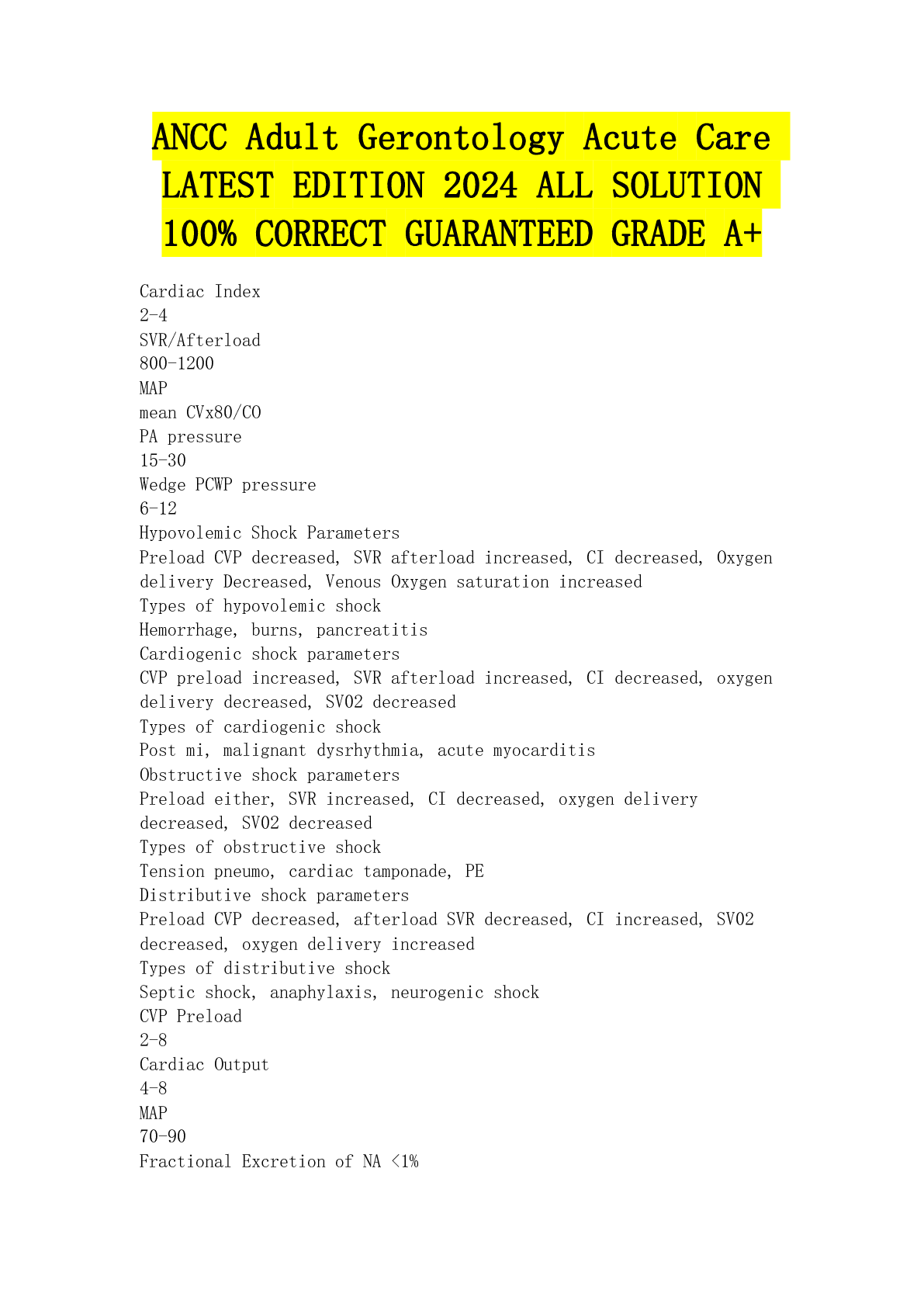
Reviews( 0 )
Document information
Connected school, study & course
About the document
Uploaded On
Jan 16, 2024
Number of pages
25
Written in
Additional information
This document has been written for:
Uploaded
Jan 16, 2024
Downloads
0
Views
15

